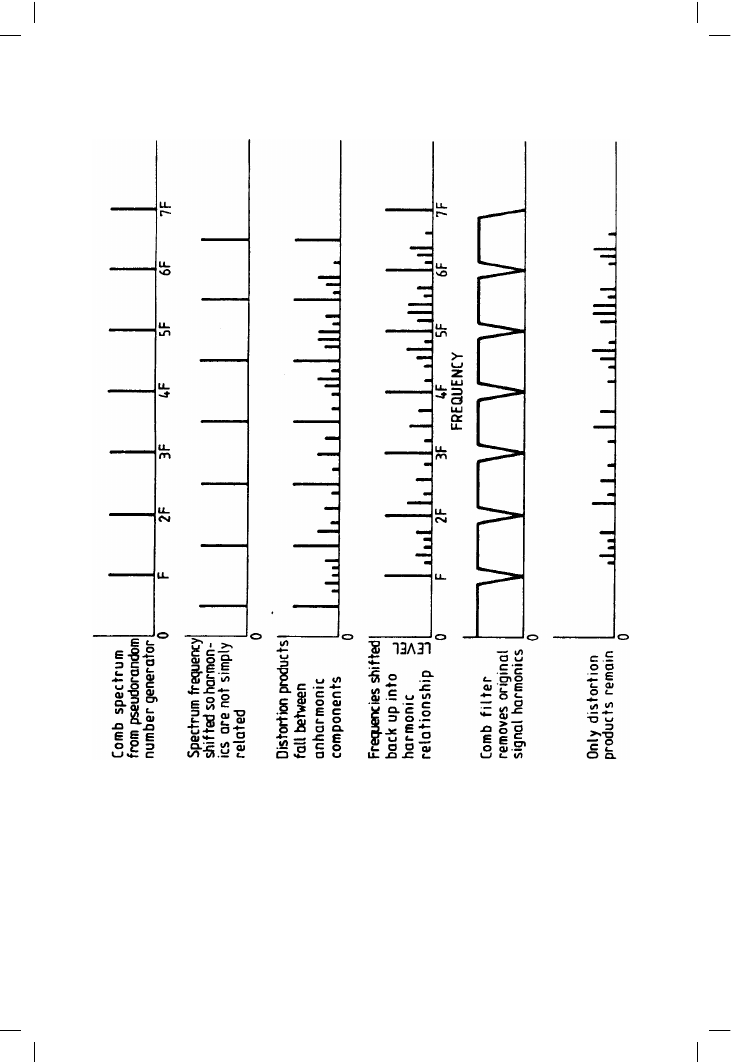ВУЗ: Казахская Национальная Академия Искусств им. Т. Жургенова
Категория: Учебное пособие
Дисциплина: Не указана
Добавлен: 03.02.2019
Просмотров: 17350
Скачиваний: 18

Audio Power Amplifier Design Handbook
It is acknowledged that THD measurements, taken with the usual notch-
type analyser, are of limited use in predicting the subjective impairment
produced by an imperfect audio path. With music, etc. intermodulation
effects are demonstrably more important than harmonics. However, THD
tests have the unique advantage that visual inspection of the distortion
residual gives an experienced observer a great deal of information about
the root cause of the non-linearity. Many other distortion tests exist which,
while yielding very little information to the designer, exercise the whole
audio bandwidth at once and correlate well with properly-conducted tests
for subjective impairment by distortion. The Belcher intermodulation test
(the principle is shown in Figure 1.1) deserves more attention than it has
received, and may become more popular now that DSP chips are
cheaper.
One of the objections often made to THD tests is that their resolution does
not allow verification that no non-linearities exist at very low level; a sort
of micro-crossover distortion. Hawksford, for example, has stated ‘Low-
level threshold phenomena . . . set bounds upon the ultimate transparency
of an audio system’
[7]
and several commentators have stated their belief
that some metallic contacts consist of a net of so-called ‘micro-diodes’. In
fact, this kind of mischievous hypothesis can be disposed of using THD
techniques.
I evolved a method of measuring THD down to 0.01% at 200 microvolts
rms, and applied it to large electrolytics, connectors of varying provenance,
and lengths of copper cable with and without alleged magic properties. The
method required the design of an ultra-low noise (EIN = –150 dBu for a 10
source resistance) and very low THD
[8]
. The measurement method is
shown in Figure 1.2; using an attenuator with a very low value of resistance
to reduce the incoming signal keeps the Johnson noise to a minimum. In no
case was any unusual distortion detected, and it would be nice to think that
this red herring at least has been laid to rest.
!
Interchannel crosstalk can obviously degrade stereo separation, but the
effect is not detectable until it is worse than 20 dB, which would be a
very bad amplifier indeed
[9]
.
!
Phase and group delay have been an area of dispute for a long time. As
Stanley Lipshitz et al have pointed out, these effects are obviously
perceptible if they are gross enough; if an amplifier was so heroically
misconceived as to produce the top half of the audio spectrum three hours
after the bottom, there would be no room for argument. In more practical
terms, concern about phase problems has centred on loudspeakers and
their crossovers, as this would seem to be the only place where a phase-
shift might exist without an accompanying frequency-response change to
make it obvious. Lipshitz appears to have demonstrated
[10]
that a second-
order all-pass filter (an all-pass filter gives a frequency-dependant phase-
shift without level changes) is audible, whereas BBC findings, reported by
10

11
Figure
1.1
Basic
principle
of
Belcher
inter
modulation
test

Audio Power Amplifier Design Handbook
Harwood
[11]
indicate the opposite, and the truth of the matter is still not
clear. This controversy is of limited importance to amplifier designers, as
it would take spectacular incompetence to produce a circuit that included
an accidental all-pass filter. Without such, the phase response of an
amplifier is completely defined by its frequency response, and vice-versa;
in Control Theory this is Bode’s Second Law
[12]
, and it should be much
more widely known in the hi-fi world than it is. A properly designed
amplifier has its response roll-off points not too far outside the audio band,
and these will have accompanying phase-shifts; there is no evidence that
these are perceptible
[8]
.
The picture of the ear that emerges from psychoacoustics and related fields
is not that of a precision instrument. Its ultimate sensitivity, directional
capabilities and dynamic range are far more impressive than its ability to
measure small level changes or detect correlated low-level signals like
distortion harmonics. This is unsurprising; from an evolutionary viewpoint
the functions of the ear are to warn of approaching danger (sensitivity and
direction-finding being paramount) and for speech. In speech perception
the identification of formants (the bands of harmonics from vocal-chord
pulse excitation, selectively emphasised by vocal-tract resonances) and
vowel/consonant discriminations, are infinitely more important than any
hi-fi parameter. Presumably the whole existence of music as a source of
pleasure is an accidental side-effect of our remarkable powers of speech
perception: how it acts as a direct route to the emotions remains profoundly
mysterious.
12
Articles of faith: the tenets of subjectivism
All of the alleged effects listed below have received considerable
affirmation in the audio press, to the point where some are treated as facts.
The reality is that none of them has in the last fifteen years proved
susceptible to objective confirmation. This sad record is perhaps equalled
only by students of parapsychology. I hope that the brief statements below
are considered fair by their proponents. If not I have no doubt I shall soon
hear about it:
Figure 1.2
THD measurements
at very low levels

Introduction and general survey
!
Sinewaves are steady-state signals that represent too easy a test for
amplifiers, compared with the complexities of music.
This is presumably meant to imply that sinewaves are in some way
particularly easy for an amplifier to deal with, the implication being that
anyone using a THD analyser must be hopelessly naive. Since sines and
cosines have an unending series of non-zero differentials, steady hardly
comes into it. I know of no evidence that sinewaves of randomly varying
amplitude (for example) would provide a more searching test of amplifier
competence.
I hold this sort of view to be the result of anthropomorphic thinking about
amplifiers; treating them as though they think about what they amplify.
Twenty sinewaves of different frequencies may be conceptually complex to
us, and the output of a symphony orchestra even more so, but to an
amplifier both composite signals resolve to a single instantaneous voltage
that must be increased in amplitude and presented at low impedance. An
amplifier has no perspective on the signal arriving at its input, but must
literally take it as it comes.
!
Capacitors affect the signal passing through them in a way invisible to
distortion measurements.
Several writers have praised the technique of subtracting pulse signals
passed through two different sorts of capacitor, claiming that the non-zero
residue proves that capacitors can introduce audible errors. My view is that
these tests expose only well-known capacitor shortcomings such as
dielectric absorption and series resistance, plus perhaps the vulnerability of
the dielectric film in electrolytics to reverse-biasing. No-one has yet shown
how these relate to capacitor audibility in properly designed equipment.
!
Passing an audio signal through cables, PCB tracks or switch contacts
causes a cumulative deterioration. Precious metal contact surfaces
alleviate but do not eliminate the problem. This too is undetectable by
tests for non-linearity.
Concern over cables is widespread, but it can be said with confidence that
there is as yet not a shred of evidence to support it. Any piece of wire passes
a sinewave with unmeasurable distortion, and so simple notions of inter-
crystal rectification or ‘micro-diodes’ can be discounted, quite apart from
the fact that such behaviour is absolutely ruled out by established materials
science. No plausible means of detecting, let alone measuring, cable
degradation has ever been proposed.
The most significant parameter of a loudspeaker cable is probably its
lumped inductance. This can cause minor variations in frequency response
at the very top of the audio band, given a demanding load impedance.
These deviations are unlikely to exceed 0.1 dB for reasonable cable
constructions (say inductance less than 4 µH). The resistance of a typical
13

Audio Power Amplifier Design Handbook
cable (say 0.1 !) causes response variations across the band, following the
speaker impedance curve, but these are usually even smaller at around
0.05 dB. This is not audible.
Corrosion is often blamed for subtle signal degradation at switch and
connector contacts; this is unlikely. By far the most common form of
contact degradation is the formation of an insulating sulphide layer on
silver contacts, derived from hydrogen sulphide air pollution. This typically
cuts the signal altogether, except when signal peaks temporarily punch
through the sulphide layer. The effect is gross and seems inapplicable to
theories of subtle degradation. Gold-plating is the only certain cure. It costs
money.
!
Cables are directional, and pass audio better in one direction than the
other.
Audio signals are AC. Cables cannot be directional any more than 2 + 2 can
equal 5. Anyone prepared to believe this nonsense won’t be capable of
designing amplifiers, so there seems no point in further comment.
!
The sound of valves is inherently superior to that of any kind of
semiconductor.
The ‘valve sound’ is one phenomenon that may have a real existence; it has
been known for a long time that listeners sometimes prefer to have a certain
amount of second-harmonic distortion added in
[13]
, and most valve
amplifiers provide just that, due to grave difficulties in providing good
linearity with modest feedback factors. While this may well sound nice, hi-
fi is supposedly about accuracy, and if the sound is to be thus modified it
should be controllable from the front panel by a ‘niceness’ knob.
The use of valves leads to some intractable problems of linearity, reliability
and the need for intimidatingly expensive (and once more, non-linear) iron-
cored transformers. The current fashion is for exposed valves, and it is not
at all clear to me that a fragile glass bottle, containing a red-hot anode with
hundreds of volts DC on it, is wholly satisfactory for domestic safety.
A recent development in subjectivism is enthusiasm for single-ended
directly-heated triodes, usually in extremely expensive monoblock sys-
tems. Such an amplifier generates large amounts of second-harmonic
distortion, due to the asymmetry of single-ended operation, and requires a
very large output transformer as its primary carries the full DC anode
current, and core saturation must be avoided. Power outputs are inevitably
very limited at 10 W or less. In a recent review, the Cary CAD-300SEI triode
amplifier yielded 3% THD at 9 W, at a cost of £3400
[14]
. And you still need
to buy a preamp.
!
Negative feedback is inherently a bad thing; the less it is used, the better
the amplifier sounds, without qualification.
14